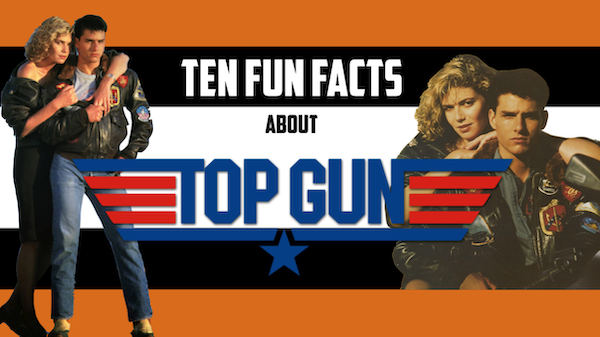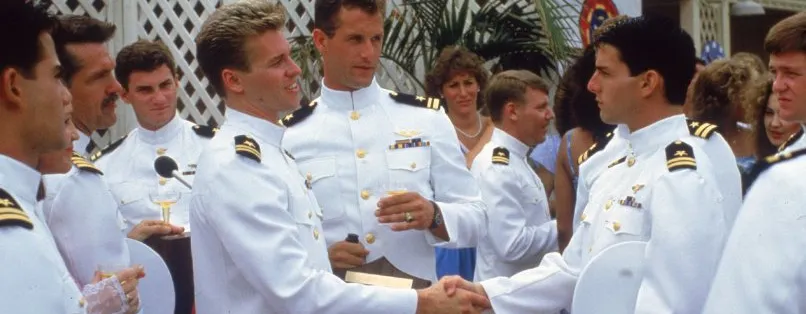Ten Fun Facts About Top Gun (1986)
We’re still flying high off the recent release of Joseph Kosinski’s Top Gun: Maverick, and we have the need, the need for speed! Climb into the cockpit and prepare to take a ride into the “Danger Zone” with us as we dish out 10 fun facts about Tony Scott’s 1986 film. Who knows, they might just be so fun that they take your breath away!
The producers sought production assistance from the US Navy, which led to several changes.
Producers Don Simpson and Jerry Bruckheimer wanted assistance from the U.S. Navy with the film’s production, which gave the Navy influence over the script and its approval. This contributed to several changes that were made to Jim Cash and Jack Epps Jr.’s screenplay. Here’s a few of the resulting changes:
The opening dogfight was moved from Cuba to international waters.
A scene involving a crash on the deck of an aircraft carrier was scraped.
Maverick’s love interest was changed from a female Navy member to a civilian contractor (because the US military's prohibition of fraternization between officers and enlisted personnel).
The Navy’s involvement wound up costing the production a lot.
To make the film and its actions more legitimate, the Navy made several F-14 aircrafts (from fighter squadron VF-51 "Screaming Eagles") available to the film and its production. Of course, all of these “toys” came at a heavy cost… Paramount paid as much as $7,800/hr (equivalent to $19,700 as of July 3, 2022) for fuel and other operating costs whenever aircrafts were flown outside their normal duties.
One story from filming involves Tony Scott cutting a check directly. He wanted to film an aircraft taking off and landing on an aircraft carrier, using the sun as a back light (like many of Top Gun’s exterior shots); however, during the filming of the sequence, the carrier’s captain had changed the ship’s course, which altered the light and ruined the effect Scott was after. When Scott asked them to revert to their previous course and speed, the captain told him it would cost hime $25,000 (equivalent to $63,000 by today’s standards) to turn the ship and continue on the specified course. Scott whipped out his checkbook and quickly wrote the captain a check for $25k so the ship could be turned, and he could continue shooting for another five minutes…
According to Scott, the check bounced!
The Navy capitalized on the film’s success.
Riding on the coattails of the film’s success, the Navy would set up recruiting booths in major cinemas around the nation to try and catch some adrenaline-charged Maverick wannabes as they exited the theater. Apparently, they experienced their highest application rate for several years as a direct result of this sneaky tactic.
But the film would get the last laugh.
The film’s massive success naturally led to millions of moviegoers parroting its many quotable lines. This got old real fast in the real-life TOPGUN School, which soon imposed a $5 fine to any staff member that’s caught quoting the film. We’d tell you how much they’ve collected, but, uh, it’s classified… we could tell you but then we'd have to kill you….
There was a future NASA astronaut amongst its crew.
One of the F-14 aircraft aviators who piloted many of the film’s stunt sequences was future NASA astronaut Scott Altman. He got the opportunity because he was stationed at NAS Miramar at the time of filming, which was the airfield the TOPGUN training program was located at. Altman was the pilot who “flipped the bird” in the film’s iconic opening sequence, and he also piloted the aircraft shown “buzzing the town” throughout the film.
Val Kilmer wanted to pass on the project.
That’s right, the Iceman was so cold-blooded, he didn’t want to be in the film. However, due to contractional obligations, he was forced to be in it. Ironically, it became one of the most iconic roles of his career, so this is one instance where studio ties panned out well.
Tom Cruise wasn’t in love with the project at first either.
From the get-go, the filmmakers were gunning Tom Cruise to play Maverick, but he kept turning them down. It wasn’t until Jerry Bruckheimer arranged for a ride along with the Blue Angels that Cruise began to change his tune.
Bruckheimer said, "So they (the Navy) take Tom up there, and they do five Gs. They do barrel rolls, they do everything. He's heaving in the plane. He gets on the tarmac, runs to a pay phone ... and he said, 'I'm in. I'm doing the movie. I love it. This is great.'"
The Maverick/Iceman beef wasn’t just for the cameras.
Cruise and Kilmer didn’t exactly get along during filming, and their off-screen attitude made their on-screen tension all the more palpable. The two kept their distance from one another and never really socialized off-camera.
The film was Kilmer’s first reported attempt at method acting, which fanned the flames. In his documentary Val, Kilmer said he “would purposefully play up the rivalry between Tom’s character and mine off-screen as well. And what ended up happening is the actors in true method fashion, split into two distinct camps.”
His helped create some good moments though, many of which happened organically. For instance, when the class is in the hanger and Maverick is bragging about how he gave “the bird” to the MiG by flying inverted, Kilmer’s cough of “bullshit” was completely ad-libbed and everyone’s reaction was genuine. According to Anthony Edwards (who played “Goose”), "A lot of the humor was discovered at the moment. The script was skeletal."
Cruise’s height caused some production hurdles.
It’s no secret that Tom Cruise is a short dude, but on Top Gun the height difference between him (5’7”) and Kelly McGillis (5’10”) really bothered Paramount. They actually made specially lifted cowboy boots for him to wear for their scenes together. To make their heights evenly matched, they also had McGillis take her shoes off as well.
The film suffered a tragedy.
This last fact isn’t “fun” by any means, but it’s an important facet to the film’s production story…
Art Scholl was a renowned aerobatic pilot who was hired to do the in-flight camerawork on the film. The script called for a flat spin, which is a difficult maneuver. Scholl was to perform the move in his Pitts S-2 camera plane and capture it on a camera that was attached to the aircraft, but things didn’t go according to plan. He failed to recover from the flat spin and plummeted into the Pacific Ocean. His final words were: "I have a problem... I have a real problem.”
The exact cause of the crash was never determined, and neither Scholl’s body or the aircraft were ever recovered. The film was dedicated to him and his memory.
Got the need for more speed?! Check out the links below:
Top Gun: Maverick review
Top Gun (1986) Drinking Game
Mission: Impossible — Fallout review
Val review
What do you think? We want to know. Share your thoughts and feelings in the comments section below, and as always, remember to viddy well!











